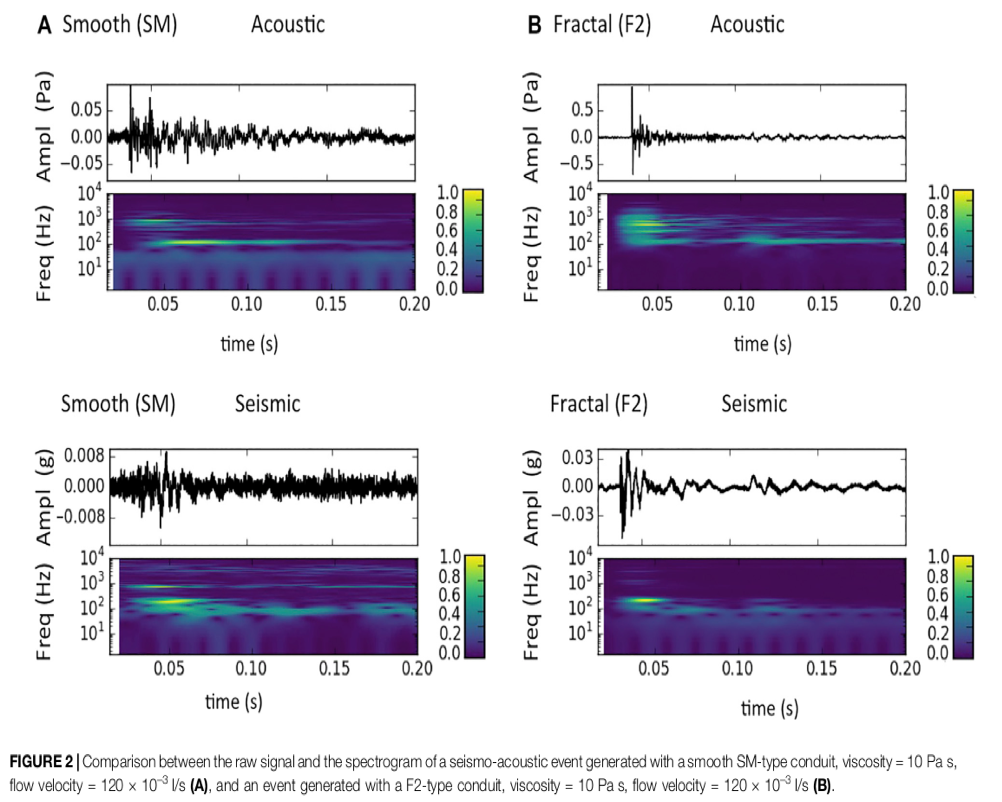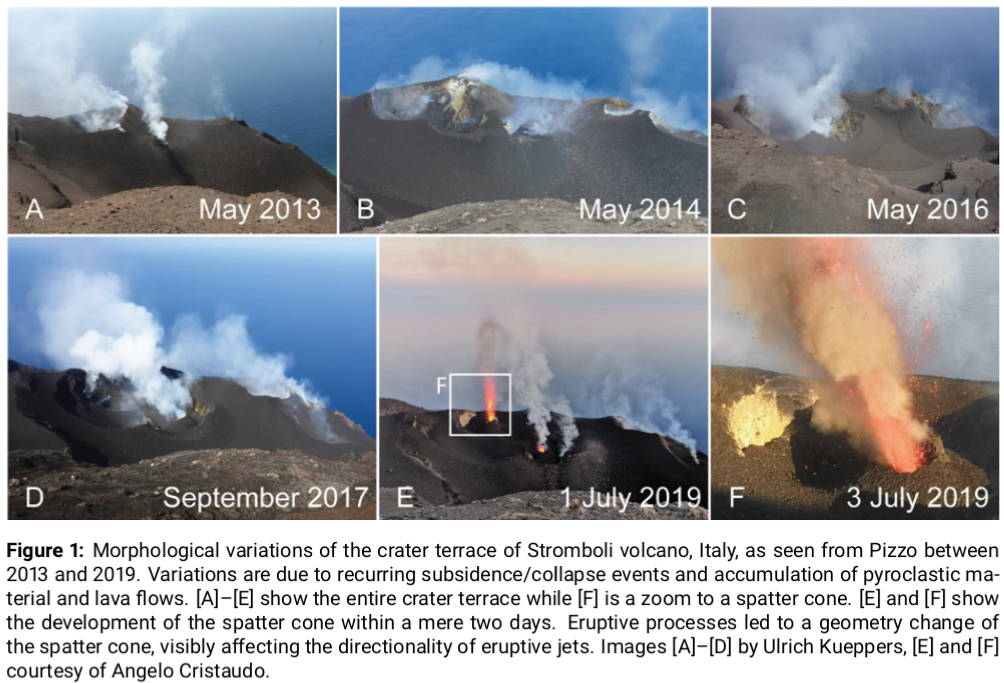Magma titanium and iron contents dictate crystallization timescales and rheological behaviour in basaltic volcanic systems
Di Fiore F., Vona A., Di Genova D., Pontesilli A., Calabrò L., Mollo S., Taddeucci J., Romano C., Scarlato P.
Magma ascending through Earth's crust undergoes complex chemical and physical changes that may induce crystallization, a process that contributes to lead the magmatic system toward a thermodynamic state of equilibrium. The diverse cooling and deformative regimes suffered by magmas heavily influence crystallization rates, solidification timescales, and consequently, the rheological evolution of magma. This, in turn, significantly impacts the dynamics of volcanic plumbing systems and the associated eruptive styles.
Here, we investigate the rheological changes in Stromboli magma (Italy) during disequilibrium crystallization under non-isothermal sub-liquidus conditions. By systematically varying the cooling rate (1-10 °C/min) and the shear rate (1-10 s-1), we find that cooling rates significantly influence the solidification path of the basalt, whereas shear rates have a subordinate effect. By comparing our results with literature data on basalts from Mt. Etna (Italy), characterized by higher of TiO2 and FeOtot contents, we observed distinct timescales and rates of solidification, contributing to unique eruptive dynamics in these volcanic plumbing systems.
Link: https://www.nature.com/articles/s43247-024-01452-1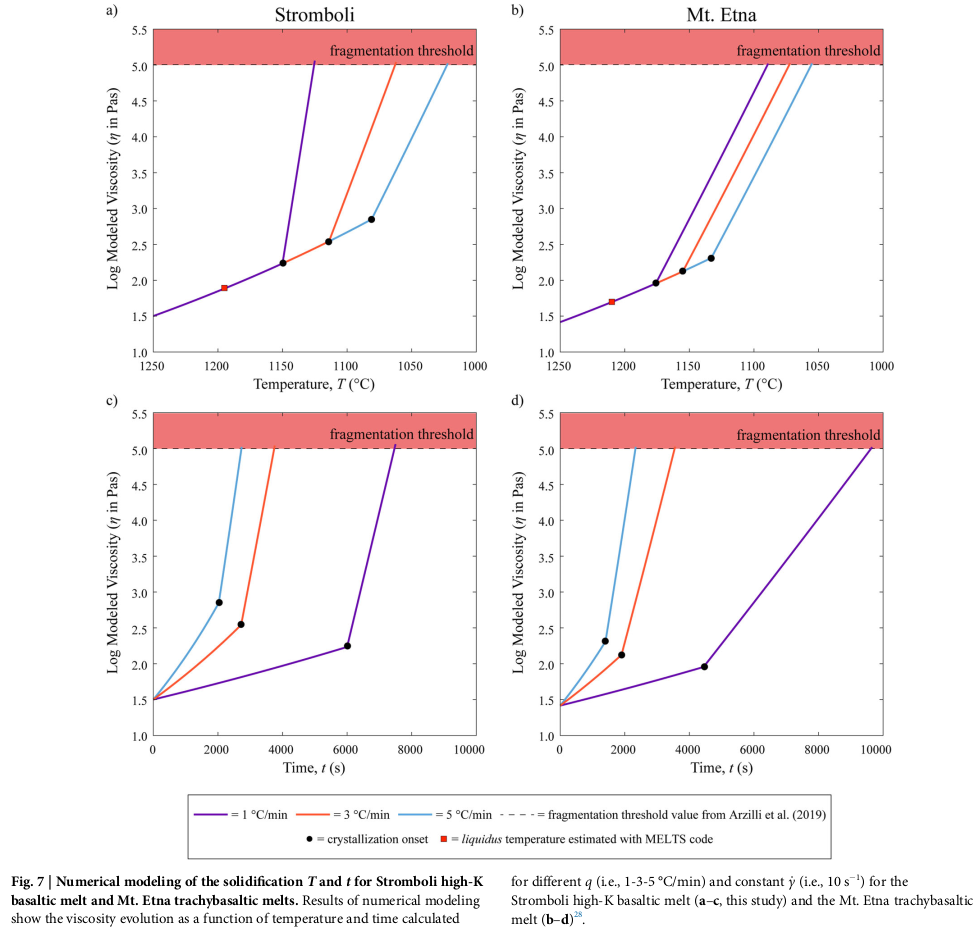
Magma Differentiation in Dynamic Mush Domains From the Perspective of Multivariate Statistics: Open‐ Versus Closed‐System Evolution
Pontesilli A., Di Fiore F., Scarlato P., Ellis B., Del Bello E., Andronico D., Taddeucci J., Brenna M., Nazzari M., Bachmann O., and Mollo S.
Volcanoes characterized by continuous eruptive activity are typified by constant replenishment of new magma, rising from deeper regions of the crust. The volcanic glass (supercooled silicate melt), represents the residual liquid of magma crystallization, and is found as the intracrystalline matrix of eruptive products. The study of its chemical composition may provide insight into the processes occurring at depths beneath the volcanic vent, where magma compositional changes result from crystallization and mixing with new magma rising from depth. We combine statistical analyses and analytical equations based on the chemical composition of the matrix glasses from Stromboli volcano, in order to constrain the processes which produce their chemical variations, identifying different environments where magmas are stored at depth. Our results also show that when magma is stored for a short period of time, the chemical changes to which the magma is subjected in a constantly replenished system are similar to those occurring in a system which is closed to new inputs of magma.
Link: https://agupubs.onlinelibrary.wiley.com/doi/pdf/10.1029/2023GC011396
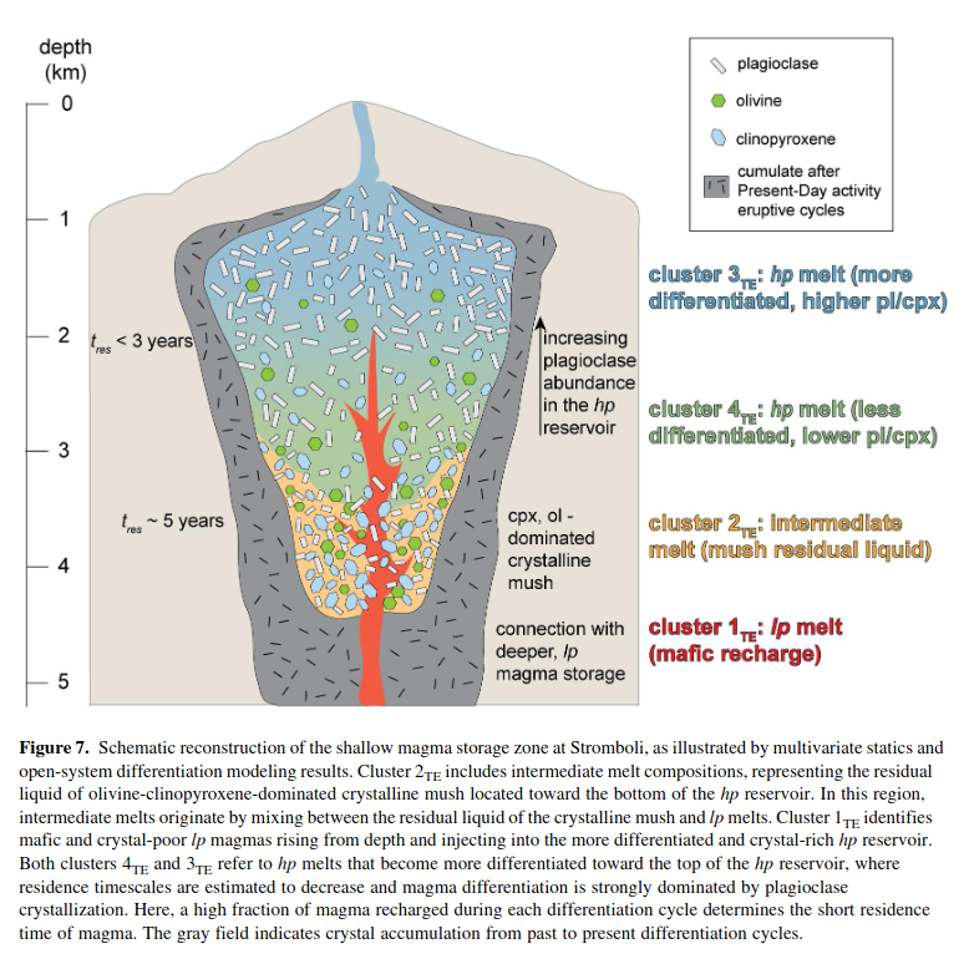
The Effect of Conduit Walls Roughness on Volcanic Jets and Their Seismo-Acoustic Radiation: An Experimental Investigation
Spina L., Taddeucci J., Pennacchia F., Morgavi D., Peña Fernández J.J., Sesterhenn J., La Spina G., and Scarlato P.
Volcanoes are amongst the most fascinating and mysterious subjects of science, for they allow no direct observation of what is happening within the conduit during eruptive activity. Indirect observations (such as measurements of the sound and vibration accompanying eruptions) are routinely performed for monitoring and research purposes. Laboratory studies mimicking the eruptive processes in small-scale devices, are of great support for correctly interpreting such data. As such, we investigated the effect of the irregularity of conduit surface, amongst the most relevant and poorly known variables characterizing the eruptive processes, on volcanic jets and on their seismic and acoustic signals. We performed a series of laboratory experiments using conduits with different roughness of the internal surface and various starting pressures. Microphones and accelerometers, capable of measuring conduit sounds and vibration, respectively, in synch with high-speed camera were used to constrain the characteristics of the generated subsonic and supersonic jets. Results show that conduit roughness controls: (a) the relative amplitude of seismic and acoustic signals; (b) the velocity, turbulence and properties of the sound of these jets. Our results will shed light on the link between observation at the surface and dynamic evolution of conduit geometry at depth.
Link: http://dx.doi.org/10.1029/2023GL104717
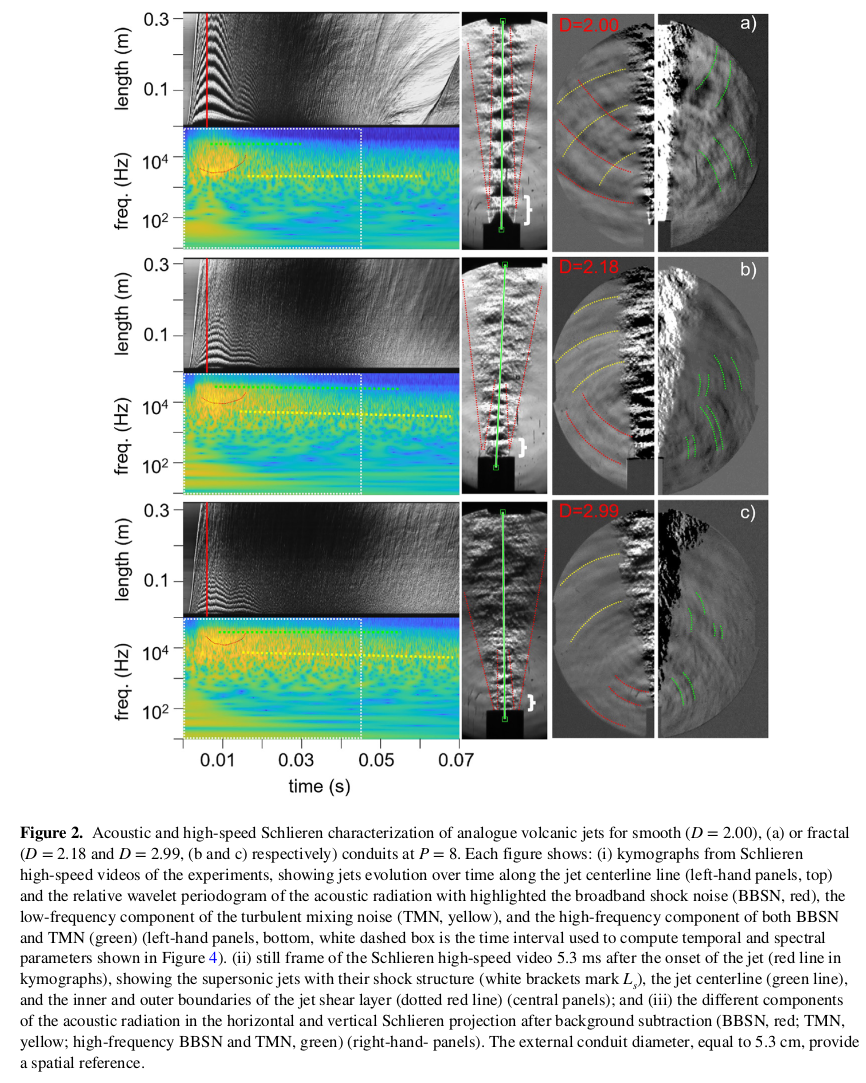
High-resolution mapping and dispersion analyses of volcanic ballistics emitted during the 3rd July 2019 paroxysm at Stromboli
Bisson M., C. Spinetti, R. Gianardi, K. Strehlow, E. De Beni & P. Landi
A detailed mapping of volcanic ballistic projectiles emplaced in a defined area, represents the starting point to derive preparatory data in hazard and risk studies of ballistics phenomena. Considering as case study the 3rd July 2019 paroxysmal eruption occurred at Stromboli volcano, we map and analyse at very high spatial resolution (8 cm) the distribution of the ballistic spatter clasts emplaced on the E flank of the volcano. The resulting map identifies and reproduces as geospatial polygon elements 152,228 spatter clasts with areal dimensions from 0.03 to 4.23 m2. Dispersed on 0.407 km2, the spatters cover an area of 29,000 m2 corresponding to an erupted products volume from 2.3 to 7.0 × 103 m3, calculated here for the first time. Spatial analyses indicate that the area mostly affected by the clasts emplacement is between N67.5 and N135 directions, identifying a preferential deposition between N112.50 and N123.75 directions. The clasts size distribution rapidly decreases with the size increase, highlighting a nearly constant ratio small/large clasts regardless the distance from the vent. Finally, additional investigations reveal that clasts dispersion parameters decrease progressively with the distance from the vent only along one direction (N67.5), highlighting how the morphology influences the deposition and remobilisation of mapped ballistics.
Link: https://www.nature.com/articles/s41598-023-39600-w
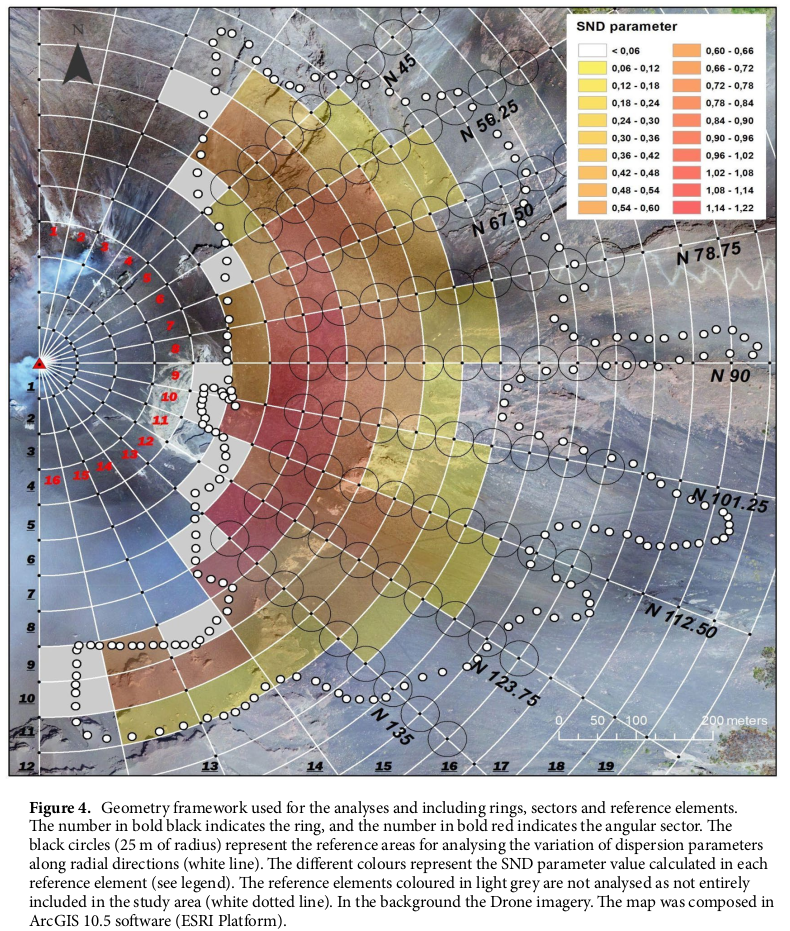
Pontesilli A., Del Bello E., Scarlato P., Mollo S., Ellis B., Andronico D., Taddeucci J., Nazzari M.
Petrological studies of active volcanoes typically focus on eruptive phenomena occurring over long timescales of the order of days to years, aiming at identifying major changes in the physico-chemical state of magma during ascent towards the surface. Exceptionally, we present results from an integrated petrological and statistical approach based on the compilation of ∼5300 major and trace element data for glass and crystals, in combination with volcanological data on eruptive events occurred over timescales of minutes at Stromboli volcano (Sicily). On May 11, 2019, we had the rare opportunity to collect individual fresh fallout ash products from eighteen mostly consecutive explosions, erupted in a 2-h time span and, at the same time, to acquire continuous high frequency (50 Hz) infrared thermal data of the same explosions. Through video analysis, we observe that explosions were more frequent and ash-dominated at the southwestern crater area (SCA, 8–10 events/h) than at the northeastern crater area (NCA, 3–5 events/h), where coarser material was ejected. The statistical analysis of glass and plagioclase compositions reveals differences in the products erupted from the two crater areas. SCA explosions tapped less differentiated magmas (Mg#∼42–46, ∼257–365 LaN, ∼0.7–0.9 Eu/Eu*) in equilibrium with more anorthitic plagioclase cores (An∼72–88), whereas NCA area explosions are more differentiated (Mg#∼40–44, ∼286–387 LaN, ∼0.6–0.8 Eu/Eu*) and in equilibrium with less anorthitic plagioclase cores (An∼68–82). Thermometric calculations based on major and trace element clinopyroxene-plagioclase-melt equilibrium modeling highlight that the SCA explosions were statistically fed by hotter magmas in comparison to NCA explosions. Plagioclase-based diffusion modeling also indicates longer timescales for the dynamic ascent of NCA magmas, leading to preferential groundmass crystallization at the conduit walls and transition from sideromelane to tachylite groundmass textures. The final emerging picture is that in May 2019, concurrent normal eruptions from different crater areas at Stromboli were heralds of compositionally and thermally diverse magmas rising at different rates within the uppermost branched part of the conduit region. High frequency petrological investigations aided by statistical treatment of data have the potential to constrain dynamic conduit processes related to transient, explosive eruptions in persistently active volcanoes, thereby offering new insights on the interplay between magma dynamics, ascent timescales, and eruptive behavior.
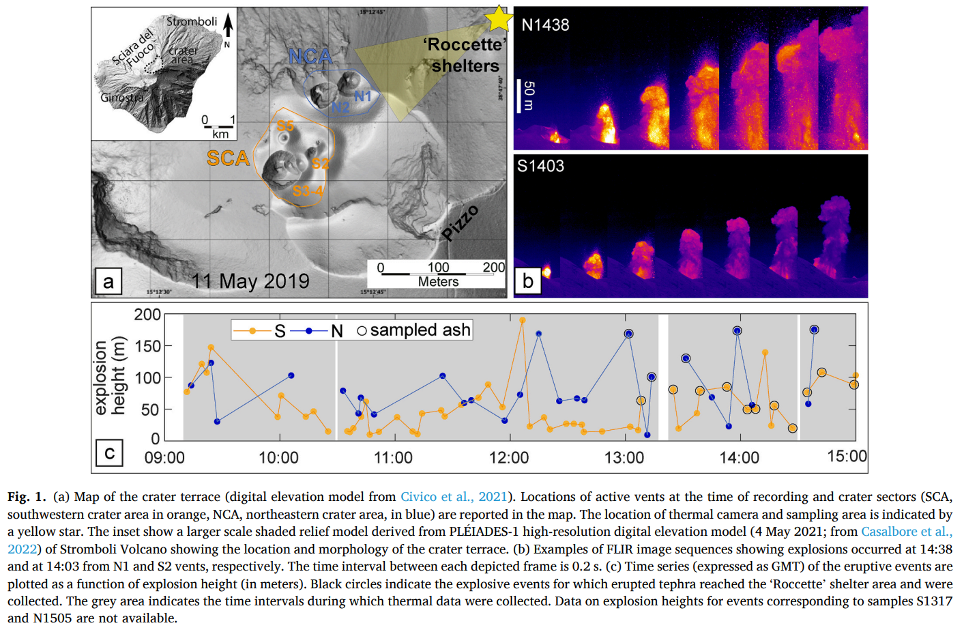
Schiavon, B., Mollo, S., Pontesilli, A., Del Bello, E., Nazzari, M., & Scarlato, P.
In this study we parameterize the textural attributes of plagioclase phenocrysts and microlites from nineteen pyroclasts ejected during mild to violent explosions at Stromboli over a timespan of ~18 years, from 2003 to 2021. By allying kinetic and crystal size distribution principles, we document that the morphological stability of large-sized, euhedral phenocrysts is superimposed on an internal textural heterogeneity due to growth-dissolution phenomena associated with the input rate of hot, H2O-rich recharge magmas rising from depth. As a result, the volumetric plagioclase proportion, dominant size, and number of phenocrysts per unit volume decrease from mild to violent explosions responding to a more efficient magma mixing process via sustained injections of mafic magmas into the shallow reservoir. On the other hand, the crystallization of anhedral plagioclase microlites is controlled by fast growth kinetics taking place in the uppermost part of the conduit during magma acceleration towards the surface. Under such highly dynamic crystallization conditions, the microlite number density closely depends on the increase of melt liquidus temperature via magma decompression and H2O exsolution. This mutualism allows to model the degassing rate and ascent velocity of magma under open-conduit flow regimes for the different eruptive styles, thereby supporting the idea that violent explosions at Stromboli are driven by sustained influxes of recharge magmas favoring strong acceleration (~12–27 m/s), decompression (~0.25–0.49 MPa/s), and H2O exsolution (~0.005–0.01 wt%/s) before magma discharge at the vent.
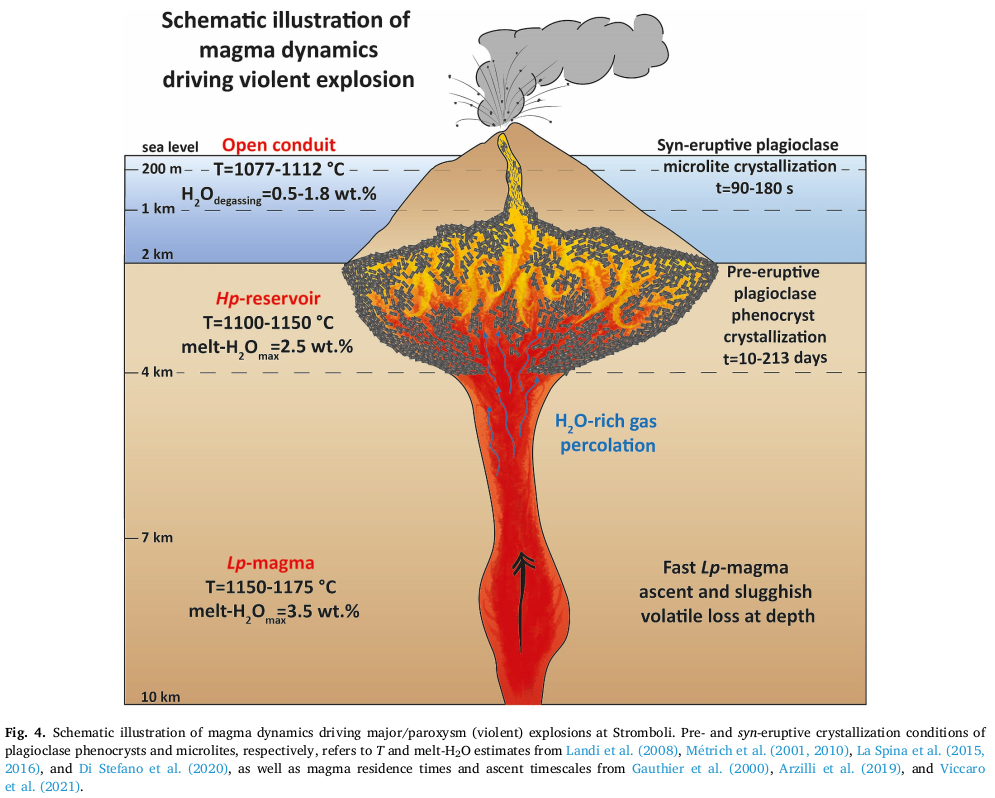
P. Moschini, S. Mollo, A. Pontesilli, M. Nazzari, C.M. Petrone, S. Fanara, A. Vona,
M. Gaeta, C. Romano, P. Scarlato
Mafic alkaline magmas, such as those feeding the persistent eruptive activity of Stromboli and Mt. Etna volcanoes in Italy, are dominated by the crystallization of plagioclase via cooling and degassing phenomena related to the dynamics of shallow crustal reservoirs and eruptive conduits. Because plagioclase textures and compositions are extremely sensitive to the changes of intensive variables in subvolcanic plumbing systems, the phenomenological variability of erupted crystals preserves detailed evidence of complex growth histories. From this point of view, we reappraise the textural maturation and compositional complexity of plagioclase by allying thermodynamic and kinetic principles to natural and experimental observations, with the purpose of drawing up guidelines for reconstructing magma dynamics in mafic alkaline volcanic settings. A multifaceted statistical method is adopted to parameterize the decay of crystal growth rate with increasing crystallization time, as relaxation kinetics prevails over melt supersaturation effects. This model parameterization is combined with the textural analysis of natural plagioclase crystals to quantify the residence time of phenocrysts in equilibrium with magmas at Stromboli and Mt. Etna and/or the timescale of rapid microlite growth during disequilibrium ascent of magmas within the conduit. The role played by temperature and melt-water content on plagioclase components and major cation substitution mechanisms is also evaluated under both isobaric-isothermal and decompression conditions. The emerging paradigm is that the influence of dissolved water on anorthite-albite exchange between plagioclase and melt is overwhelmingly mitigated by changes in temperature at conditions of P = 30–300 MPa, T = 1050–1150 ◦ C, fO2 = NNO + 1.9-NNO + 2.3, and melt-H2O = 0.6–4.4 wt%. As a corollary, anorthite and albite melt activities are almost fully encapsulated in the variation of anhydrous melt components as the crystallization of plagioclase proceeds during magma cooling. Following this line of reasoning, we propose an integrated modeling approach to decipher complex zoning patterns in natural plagioclase phenocrysts from mafic alkaline eruptions. Key findings from our re-assessment of equilibrium, thermometric, and hygrometric models indicate that temperature and dissolved water can be iteratively estimated for different plagioclase textural patterns if crystals are sufficiently strongly zoned and probability-based criteria are applied to determine the maximum probability distribution from kernel density analysis.
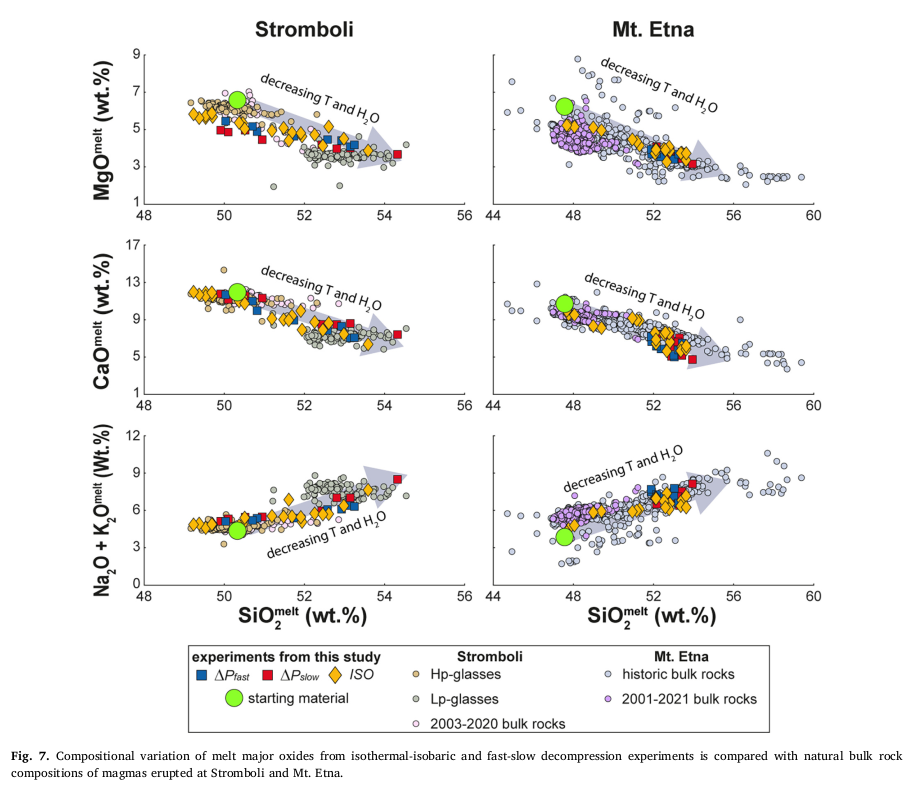
Patrizia Landi, Claudia D’Oriano, Maurizio Petrelli, Manuela Nazzari, Daniele Andronico
Stromboli (Italy) is a basaltic volcano characterized by persistent, mild strombolian activity, occasionally interrupted by lava effusion and more violent explosive events, named major explosions and paroxysms depending on their intensity and magnitude. The normal activity is fed by a shallow and degassed highly porphyritic (HP) shoshonitic basalt carrying about 50 vol.% crystals settled in a shoshonitic glassy matrix ( K 2 O > 3.8 wt.%). The more energetic explosions erupt a deep, volatile-rich, low-porphyritic (LP) magma with < 10 vol.% crystals in a shoshonitic basaltic glassy matrix ( K 2 O < 2.4 wt.%). Products with intermediate glass composition are also found in the more violent explosive events. In this study, we present a new data set of major and trace element contents in matrix glasses and minerals performed in products from different types of explosive activity that occurred at Stromboli between 1998 and 2020. This large data set is used to put constraints on the evolution and architecture of the intermediate plumbing system, where the transformation from LP to HP occurs. Results indicate that, compared to paroxysms, the glassy matrices of the LP pumices from major explosions are richer in incompatible trace elements (and K 2 O wt.%) due to < 15 wt.% fractionation of clinopyroxene and olivine. This points to a chemical zoning of the deep reservoir and suggests that major explosions are fed by magmas residing in its upper part. Among the major explosions, the homogeneous intermediate glasses in the products from the 19 July 2020 event originate from the interplay of mixing and crystal fractionation processes. The crystallization of euhedral microphenocrysts of An-rich plagioclase suggests that batches of magma can pond and crystallize for few days (< 11) at the base of the intermediate zone of the plumbing system, at pressure coinciding with the entering of plagioclase into the system (< 100 MPa). As a relevant point for understanding the pre- and syn-eruptive magma dynamics, data indicate a positive correlation between the magnitude of the explosions and the depth of the supply magma.
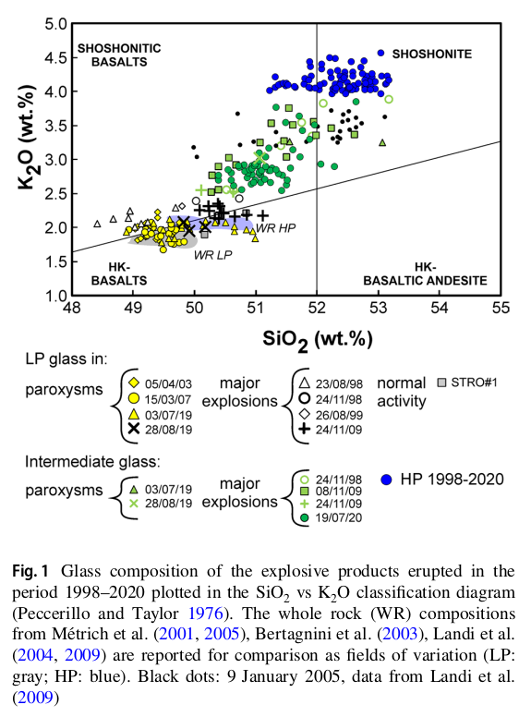
The electrical signature of mafic explosive eruptions at Stromboli volcano, Italy
Caron EJ Vossen, Corrado Cimarelli, Alec J Bennett, Markus Schmid, Ulrich Kueppers, Tullio Ricci, Jacopo Taddeucci
Volcanic lightning is commonly observed in explosive volcanic eruptions of Volcanic Explosivity Index (VEI) > 2 and can be detected remotely providing real-time volcano monitoring information. However, little is known about the electrical activity accompanying the lower-magnitude spectrum of explosive eruptions, often involving mafic magmas. We narrow this gap in knowledge by presenting the electrical signature of the explosive activity (VEI ≤ 1) of Stromboli volcano (Italy) recorded by an electrostatic thunderstorm detector. The persistent eruptive activity of mild Strombolian explosions is occasionally interrupted by larger-scale major explosions and paroxysmal events. Here, we present electrical observations of three major explosions and unprecedented measurements of the 3 July 2019 paroxysm. The electrical signals of the major explosions show apparent similarities, with movements of charge and tens of electrical discharges, arising the question of whether these observations could be used to supplement the classification scheme of explosions on Stromboli. The electrical signals from the 3 July 2019 paroxysm exceed those from the major explosions in amplitude, discharge rate and complexity, showing characteristic variations during different phases of the eruption. These results show that also impulsive lower-magnitude explosions generate detectable electrical activity, which holds promise for monitoring low VEI activity at mafic volcanoes.
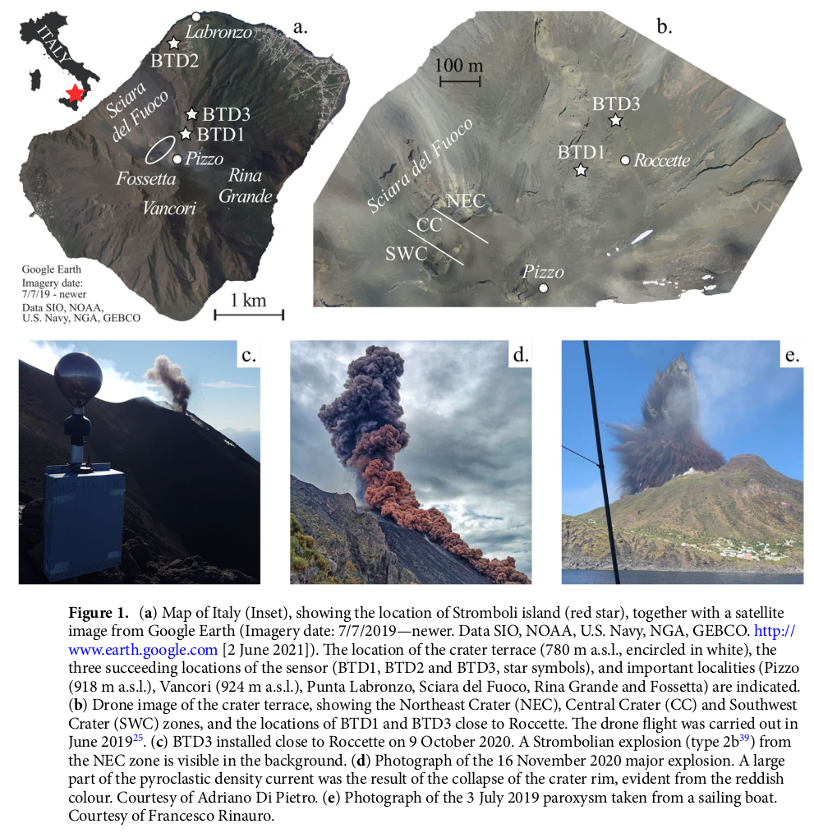
Uncovering the eruptive patterns of the 2019 double paroxysm eruption crisis of Stromboli volcano
Daniele Andronico, Elisabetta Del Bello, Claudia D’Oriano, Patrizia Landi, Federica Pardini, Piergiorgio Scarlato, Mattia de’ Michieli Vitturi, Jacopo Taddeucci, Antonino Cristaldi, Francesco Pennacchia, Tullio Ricci, Federico Valentini
In 2019, Stromboli volcano experienced one of the most violent eruptive crises in the last hundred years. Two paroxysmal explosions interrupted the ‘normal’ mild explosive activity during the tourist season. Here we integrate visual and field observations, textural and chemical data of eruptive products, and numerical simulations to analyze the eruptive patterns leading to the paroxysmal explosions. Heralded by 24 days of intensified normal activity and 45 min of lava outpouring, on 3 July a paroxysm ejected ~6 × 10 7 kg of bombs, lapilli and ash up to 6 km high, damaging the monitoring network and falling towards SW on the inhabited areas. Intensified activity continued until the less energetic, 28 August paroxysm, which dispersed tephra mainly towards NE. We argue that all paroxysms at Stromboli share a common pre-eruptive weeks-to months-long unrest phase, marking the perturbation of the magmatic system. Our analysis points to an urgent implementation of volcanic monitoring at Stromboli to detect such long-term precursors.
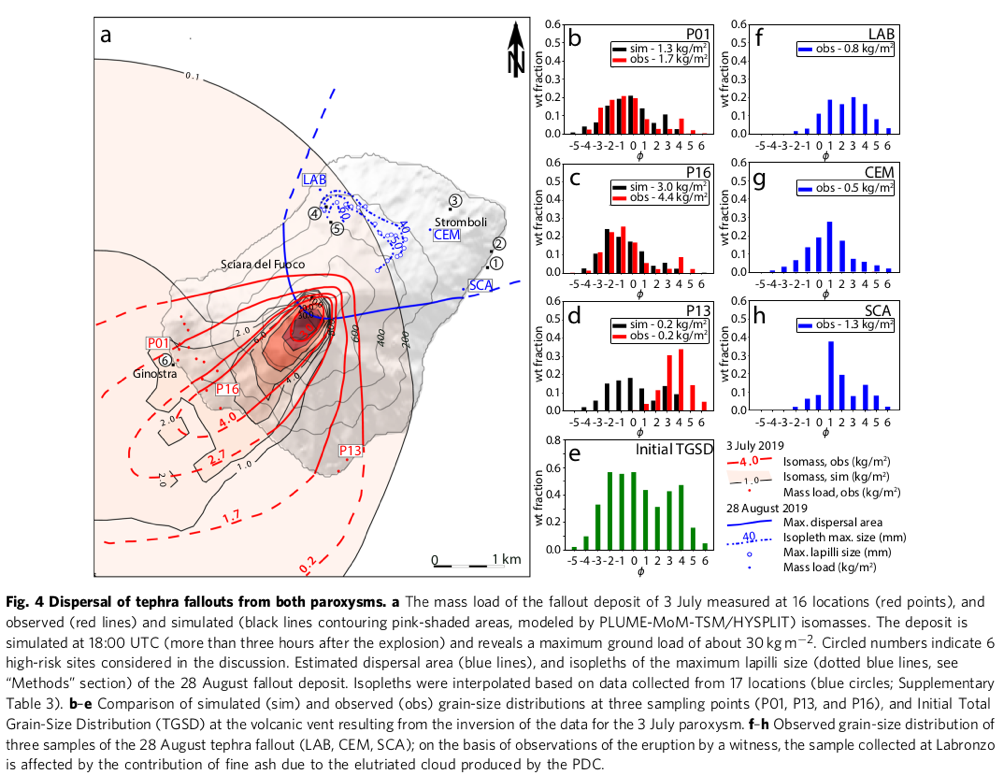
Clustering of Experimental Seismo-Acoustic Events Using Self-Organizing Map (SOM)
Flora Giudicepietro, Antonietta M. Esposito, Laura Spina, Andrea Cannata, Daniele Morgavi, Lukas Layer and Giovanni Macedonio
The analogue experiments that produce seismo-acoustic events are relevant for understanding the degassing processes of a volcanic system. The aim of this work is to design an unsupervised neural network for clustering experimental seismo-acoustic events in order to investigate the possible cause-effect relationships between the obtained signals and the processes. We focused on two tasks: 1) identify an appropriate strategy for parameterizing experimental seismo-acoustic events recorded during analogue experiments devoted to the study of degassing behavior at basaltic volcanoes; 2) define the set up of the selected neural network, the Self-Organizing Map (SOM), suitable for clustering the features extracted from the experimental events. The seismo-acoustic events were generated using an ad hoc experimental setup under different physical conditions of the analogue magma (variable viscosity), injected gas flux (variable flux velocity) and conduit surface (variable surface roughness). We tested the SOMs ability to group the experimental seismo-acoustic events generated under controlled conditions and conduit geometry of the analogue volcanic system. We used 616 seismo-acoustic events characterized by different analogue magma viscosity (10, 100, 1000 Pa s), gas flux (5, 10, 30, 60, 90, 120, 150, 180 × 10 −3 l/s) and conduit roughness (i.e. different fractal dimension corresponding to 2, 2.18, 2.99). We parameterized the seismo-acoustic events in the frequency domain by applying the Linear Predictive Coding to both accelerometric and acoustic signals generated by the dynamics of various degassing regimes, and in the time domain, applying a waveform function. Then we applied the SOM algorithm to cluster the feature vectors extracted from the seismo-acoustic data through the parameterization phase, and identified four main clusters. The results were consistent with the experimental findings on the role of viscosity, flux velocity and conduit roughness on the degassing regime. The neural network is capable to separate events generated under different experimental conditions. This suggests that the SOM is appropriate for clustering natural events such as the seismo-acoustic transients accompanying Strombolian explosions and that the adopted parameterization strategy may be suitable to extract the significant features of the seismo-acoustic (and/or infrasound) signals linked to the physical conditions of the volcanic system.
Characterising vent and crater shape changes at Stromboli: implications for risk areas
Markus Schmid , Ulrich Kueppers, Riccardo Civico, Tullio Ricci, Jacopo Taddeucci, Donald B Dingwell
Active volcanoes are typically subject to frequent substantial topographic changes as well as variable eruption intensity, style and/or directionality. Gravitational instabilities and local accumulation of pyroclasts affect conditions at the active vents, through which gas-particle jets are released. In turn, the vent geometry strongly impacts the eruption characteristics. Here, we compare five high-resolution topographic data sets (<4 cm/pixel) of volcanic craters and vents from Stromboli volcano, Italy, that were acquired by unoccupied aerial vehicle (UAV) during five field campaigns between May 2019 and January 2020. This period includes two paroxysmal explosions (3 July and 28 August 2019) and exhibited significant changes on day-to-month timescales. Our results highlight changes to vent geometry and their strong control on the directionality of explosions. Recurrent UAV surveys enable the monitoring of temporal morphologic changes and aid the interpretation of observed changes in eruption style. Ultimately, this may contribute to repeatedly revised risk areas on permanently active volcanoes, especially those that are important tourist destinations.
Riccardo Civico, Tullio Ricci, Piergiorgio Scarlato, Daniele Andronico, Massimo Cantarero, Brett B. Carr, Emanuela De Beni, Elisabetta Del Bello, Jeffrey B. Johnson, Ulrich Kueppers, Luca Pizzimenti, Markus Schmid, Karen Strehlow and Jacopo Taddeucci
In July and August 2019, two paroxysmal eruptions dramatically changed the morphology of the crater terrace that hosts the active vents of Stromboli volcano (Italy). Here, we document these morphological changes, by using 2259 UAS-derived photographs from eight surveys and Structure-from-Motion (SfM) photogrammetric techniques, resulting in 3D point clouds, orthomosaics, and digital surface models (DSMs) with resolution ranging from 8.1 to 12.4 cm/pixel. We focus onthe morphological evolution of volcanic features and volume changes in the crater terrace and the upper part of the underlying slope (Sciara del Fuoco). We identify both crater terrace and lava field variations, with vents shifting up to 47 m and the accumulation of tephra deposits. The maximum elevation changes related to the two paroxysmal eruptions (in between May and September 2019) range from +41.4 to − 26.4 m at the lava field and N crater area, respectively. Throughout September 2018–June 2020, the total volume change in the surveyed area was +447,335 m 3. Despite Stromboli being one of the best-studied volcanoes worldwide, the UAS-based photogrammetry products of this study provide unprecedented high spatiotemporal resolution observations of its entire summit area, in a period when volcanic activity made the classic field inspections and helicopter overflights too risky. Routinely applied UAS operations represent an effective and evolving tool for volcanic hazard assessment and to support decision-makers involved in volcanic surveillance and civil protection operations.
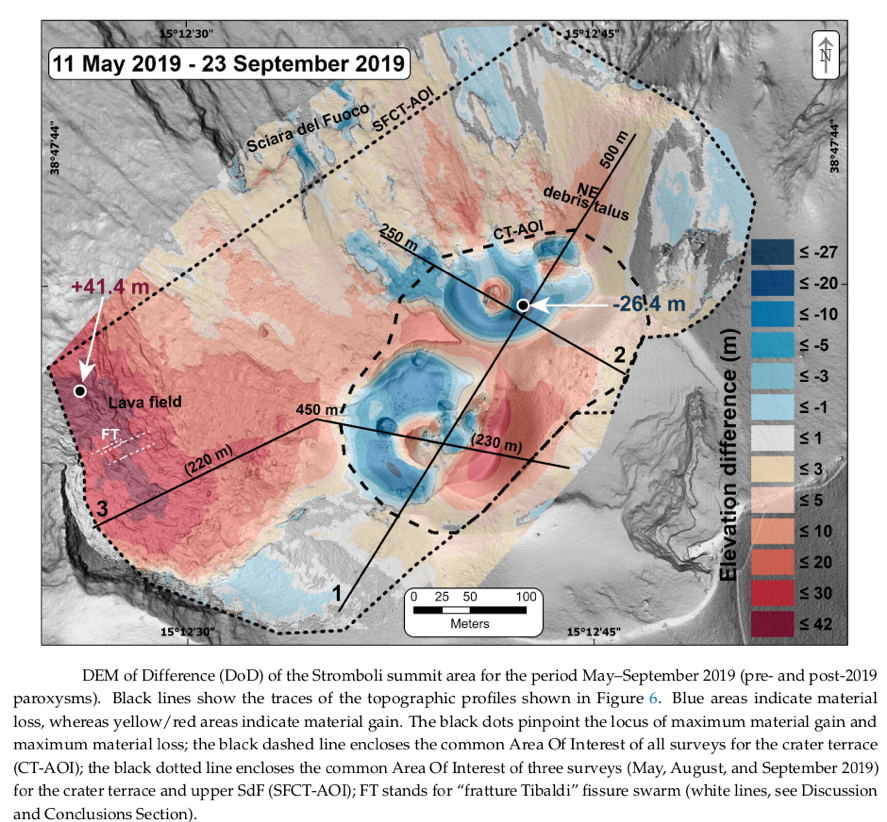
Fracturing and healing of basaltic magmas during explosive volcanic eruptions
J. Taddeucci, C. Cimarelli, M. A. Alatorre‑Ibargüengoitia, H. Delgado-Granados, D. Andronico, E. Del Bello, P. Scarlato & F. Di Stefano
The eruption of basaltic magmas dominates explosive volcanism on Earth and other planets within the Solar System. The mechanism through which continuous magma fragments into volcanic particles is central in governing eruption dynamics and the ensuing hazards. However, the mechanism of fragmentation of basaltic magmas is still disputed, with both viscous and brittle mechanisms having been proposed. Here we carry out textural analysis of the products of ten eruptions from seven volcanoes by scanning electron microscopy. We find broken crystals surrounded by intact glass that testify to the brittle fragmentation of basaltic magmas during explosive activity worldwide. We then replicated the natural textures of broken crystals in laboratory experiments where variably crystallized basaltic melt was fragmented by rapid deformation. The experiments reveal that crystals are broken by the propagation of a network of fractures through magma, and that afterwards the fractures heal by viscous flow of the melt. Fracturing and healing affect gas mobility, stress distribution, and bubble and crystal size distributions in magma. Our results challenge the idea that the grain size distribution of basaltic eruption products reflects the density of fractures that initially fragmented the magma and ultimately indicate that brittle fracturing and viscous healing of magma may underlie basaltic explosive eruptions globally.
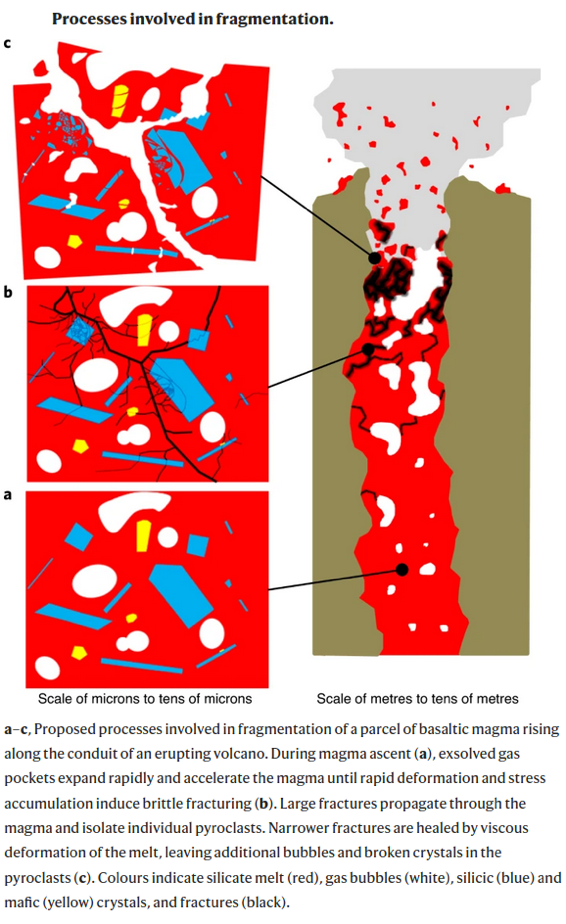
https://doi.org/10.1038/s41561-021-00708-1


